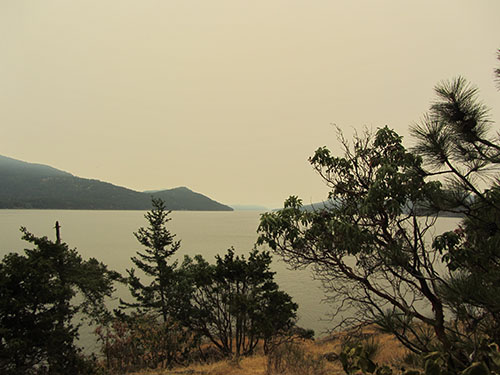Council Member Gene Knapp has repeatedly said that Orcas Islanders “are anything but apathetic,” and the last meeting regarding the proposed Country Corner LAMIRD on Monday, July 13 was a lively case in point as area neighbors discussed stormwater, drinking water and water/sewer hookup in the area.
Although County Senior Planner Colin Maycock said the purpose of the meeting was to discuss land use of the proposed zone, and possible discussion of the development tables as well, neighbors of the proposed LAMIRD at Country Corner expressed their fears and frustration that designation of the area as a LAMIRD will result in further development, on one hand, and neglect by county officials on the other, of their area.
Maycock started the meeting by saying that county staff recommends the creation of a Commercial Limited Area of More Intense Rural Development (LAMIRD) at the tri-corner “Country Corner” intersection.
The proposed LAMIRD of 16.29 acres lies within the Eastsound Sub-area Plan, but outside the Eastsound Growth Management Area (GMA) boundaries.
That situation contains the germ for the concerns of nearby neighbors: that the controlling agency for the area’s water and septic system control — the County and the Eastsound Sewer and Water District — has not been defined.
The six-parcel proposed LAMIRD has been carved from a larger LAMIRD study area that originally extended north to Mount Baker Road.( See page 7 of the July 9 memo: https://sanjuanco.com/CDP/docs/CountyCornerLAMIRD
The proposed LAMIRD “incorporates all parcels that constituted the built commercial environment in 1990 at this location,” said Maycock.
Because the “built environment” meets GMA requirements for a LAMIRD, County planning staff have decided that the “proposed boundary is logical and consistent with the GMA.”
A new zone — Country Corner Commercial — will be created to regulate development in the LAMIRD, Maycock said, and activities in the new zone “will be based on county code for allowable and prohibited uses in activity center Land Use Districts, according to existing uses and community input.”
As Maycock began to explain development standards, the issues of stormwater run-off diverted the discussion.
Maycock offered that “Stormwater issues should be dealt with onsite as part of project development program,” and that the long-range drainage plan for Eastsound has “three separate plans within LAMIRD study area.”
However, he added that those plans, while in place, “are at the bottom of the list of things to be done.”
Rebecca Shapiro, a Montgomery Lane homeowner adjacent to Country Corner, said that properties on her road at times are “inundated with water, but there’s no drain off. Half a block or a block away the water runs down streets — supposedly taken care of by drainage — but it isn’t.”
“No government has made any effort to update or check out drainage and it’s not working,” Shapiro added. “How can they possibly have more development when they aren’t taking care of what’s already developed”
Others in the meeting of about 20 concurred with Shapiro’s complaints, saying that pipes have been broken for years and existing stormdrains aren’t working.
Maris Bartlett said that runoff “fixes” are “put in piecemeal” and that the neighborhood is “caught between Buck Mountain and the sea.”
The group added that they have had no response to their complaints to the county road department.
County Prosecutor Randy Gaylord attended the meeting to answer questions and was peppered with comments, beginning with questions about the LAMIRD’s relation to the Eastsound Sewer and Water District.
Gaylord stated that although Country Corner is currently not served by the sewer district, the district has “made some effort to provide services ouside Eastsound,” namely at Orcas Landing and a portion of the Rosario area.
The sewer district does have plans to extend lines out to Country Corner, as it is contained within the Eastsound Sub-area part of the Sewer District’s plan, Gaylord said. He explained, however, that when the County’s Comprehensive Plan was amended last year to comply with the Growth Management Act (GMA), the County Council “only adopted the portion of [the sewer district] plan which served the Eastsound UGA.”
State law says sewers districts can serve areas outside UGA areas as long as they don’t extend urban service to rural space. Because LAMIRDs are “more intensive” rural districts, state law allows them to be served independently of UGAs, “as a function of cost,” said Gaylord.
He added that county code dictates “there would be no new connections to sewers in LAMIRDs where that service doesn’t exist prior to 2000.”
This area would have to be served by septic systems and some other arrangement until code is changed – even if approved as a LAMIRD, Gaylord concluded. “It would hold true whether there’s a LAMIRD or not.”
The question then arose if the sewer district can force people to hook up to its lines, and then a new set of decision-making enters in, considering financing mechanisms and county code.
If hook-up is done as part of a Limited Improvement District (LID) and “property benefits from it, [homeowners] would have to hook up,” said Gaylord.
He stated further that before the sewer district can install a water line, the county must issue a permit.
Patty Miller, member of the Eastsound Planning Review Committee (EPRC) stated that the problem is that “two different legal entities with the right to enforce property owners [are involved].” The sewer district says those who are in their service area can legally be forced to hook up, but the county says that hookup can’t be forced, said Miller.
The discussion expanded to include sewer service to those in the sewer district.
Paul Kamin, General Manager of the Eastsound Water Users Association said that urban level for water systems are not not defined in the same way as urban level for sewer systems.
Although Gaylord reiterated that there is nothing in county code to mandate hookup, he also concurred that if a LAMIRD is in place, there may be a rationale for the county to change its code.
In that case, people with existing homes “could be made to connect even though they have an existing septic system.”
“Under the current code and current arrangements, I can’t say who will win,” Gaylord said.
Carl Yurdin, an Eastsound Sewer and Water District (ESWD) commissioner spoke in defense of water and sewer lines, asking “Why is there not public concern for our water — safe drinking water? Wells are being polluted by failed septic systems, we just want to get people so groundwater is safe for people to drink.”
When someone answered that “nothing is wrong with the drinking water right now,” Yurdin asked if people want to wait until something is wrong with water.
He added that the LAMIRD process “seems like an opportunity; the key is to make progress beautiful. You have an opportunity to make it right”
Gaylord explained that the purpose of a LAMIRD is “to authorize and allow some changes and put boundaries on rural places that exist, that aren’t urban.”
Sometimes at a place like this — a crossroad where four or five operating businesses are already developed.”
He added that a LAMIRD also exists at the Island Hardware intersection on Crow Valley Road.
“At the end you have a set of regulations that look at existing businesses for what can occur in the future, to protect the area, legitimize it, and allow changes in business types without fear of it being non-conforming rural farm forest land.”
The rest of the Country Corner LAMIRD study area will go back to rural farm forest designation which prohibits development such as that existing at Country Corner.
The group then broke out into smaller discussion groups to comment on development standards.
The next step in the Country Corner LAMIRD process is for a draft plan to be completed in mid-August. The schedule calls for the draft to go to the Planning Commission on Sept. 17 for discussion at its first public hearing.
Following that meeting, the plan could be returned to the Planning Department or advance to the County Council.
A second public hearing will then probably be held on Orcas Island, said Maycock.






